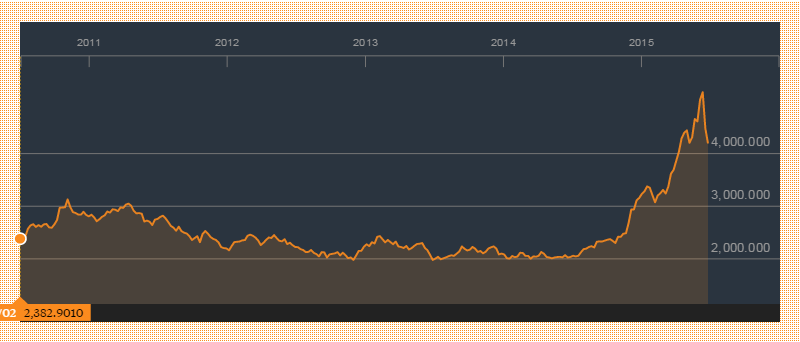Newswires in the forex world may be dominated by headlines on the Greek debt talks these days so I thought y’all should know that the Chinese central bank has been quietly making unprecedented moves. Here’s the lowdown on their latest easing efforts.
Easing, you say? What exactly did they do?
As my buddy Pip Diddy mentioned in his Asian session recap last Thursday, the People’s Bank of China (PBoC) announced that they’d be pumping up liquidity to the tune of 35 billion yuan in order to “stabilize market expectations.” Before financial market participants could even digest what this statement meant, the PBoC followed it up with a 0.25% benchmark interest rate cut, a 0.25% deposit rate cut, and a reduction of 50 basis points on the reserve ratio requirement (RRR).
All in all, these moves have the combined effect of increasing the amount of cash in circulation. If you’re thinking that this isn’t really a big deal, then you should know that this particular PBoC easing combo hasn’t been served since 2008! In addition, these are being compared to former Fed head Alan Greenspan’s stimulus strategies during the U.S. market meltdown back in 1987.
Yikes! Is the Chinese economy on the verge of a meltdown?
A quick look at the long-term chart of the Shanghai Composite Index, which basically shows how the Chinese equity market is faring, indicates a relatively good performance for the past five years.
As you can see from the chart above, the index has more than doubled in value over the past year, reaching record highs earlier this month. This prompted the PBoC to secretly drain funds from the country’s financial system in order to prevent the stock market from overheating and to keep a lid on volatility.
However, analysts say that this surprise move actually caused investors to panic, triggering a 20% decline in the Chinese equity market in the days that followed. The Shanghai Composite Index chalked up a 7.4% tumble on Friday, bringing its value down 18.8% from its June 12 high and leading PBoC officials to panic as well.
Wait a minute. Are Chinese policymakers taking their cues from the stock market and not economic data?
It does seem that way, as the PBoC clarified that their recent easing efforts have been geared at stabilizing the Chinese equity market. Of course you also have to remember that large companies listed in the Chinese stock exchange account for a huge chunk of manufacturing activity, investment, and exports — all of which make a considerable contribution to overall economic growth. While there’s no denying that China’s weakening economic figures warranted central bank stimulus months ago, it does make sense that PBoC officials are being more sensitive to stock market cues.
All right, I’ll bite. So what can this mean for the forex market?
Well, it doesn’t really mean much for the Chinese yuan’s forex levels since the PBoC sets a trading range for its currency. Note that the Chinese central bank set its USD/CNH benchmark midpoint rate slightly lower in response to the U.S. Treasury’s calls for yuan appreciation. However, these PBoC easing moves are likely to limit the currency’s gains and keep it within the central bank’s desired levels.
Increased stimulus in China could have a more pronounced impact on the commodity currencies if the rise in lending and spending in the world’s second largest economy translates to higher demand for raw materials. A pickup in business activity in China could mean rising volumes of iron ore imports from Australia and a rebound in whole milk powder shipments from New Zealand, which could then lead to better trade figures for both economies and gains for their currencies.
For the record, though, the PBoC has been on an easing spree for the past months, yet their efforts failed to give a strong boost to Chinese growth prospects. They’ve already cut interest rates four times since November 2014 and have announced several reductions in their RRR so far this year, yet these have barely translated to export gains for the commodity-dependent countries. Are the PBoC’s monetary policy tools losing their magic?
Recommended Content
Editors’ Picks
AUD/USD posts gain, yet dive below 0.6500 amid Aussie CPI, ahead of US GDP

The Aussie Dollar finished Wednesday’s session with decent gains of 0.15% against the US Dollar, yet it retreated from weekly highs of 0.6529, which it hit after a hotter-than-expected inflation report. As the Asian session begins, the AUD/USD trades around 0.6495.
USD/JPY finds its highest bids since 1990, approaches 156.00

USD/JPY broke into its highest chart territory since June of 1990 on Wednesday, peaking near 155.40 for the first time in 34 years as the Japanese Yen continues to tumble across the broad FX market.
Gold stays firm amid higher US yields as traders await US GDP data

Gold recovers from recent losses, buoyed by market interest despite a stronger US Dollar and higher US Treasury yields. De-escalation of Middle East tensions contributed to increased market stability, denting the appetite for Gold buying.
Ethereum suffers slight pullback, Hong Kong spot ETH ETFs to begin trading on April 30

Ethereum suffered a brief decline on Wednesday afternoon despite increased accumulation from whales. This follows Ethereum restaking protocol Renzo restaked ETH crashing from its 1:1 peg with ETH and increased activities surrounding spot Ethereum ETFs.
Dow Jones Industrial Average hesitates on Wednesday as markets wait for key US data

The DJIA stumbled on Wednesday, falling from recent highs near 38,550.00 as investors ease off of Tuesday’s risk appetite. The index recovered as US data continues to vex financial markets that remain overwhelmingly focused on rate cuts from the US Fed.
